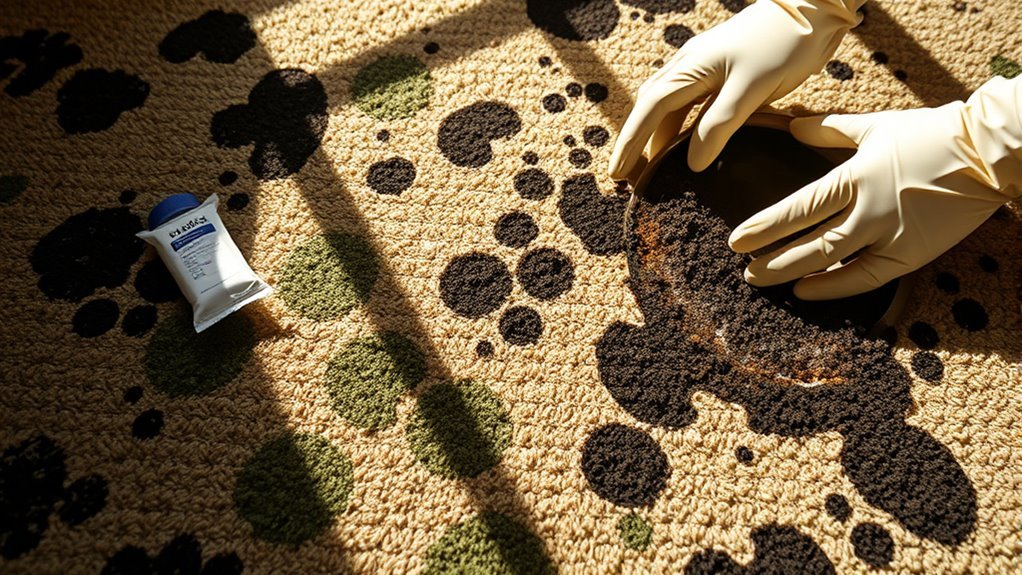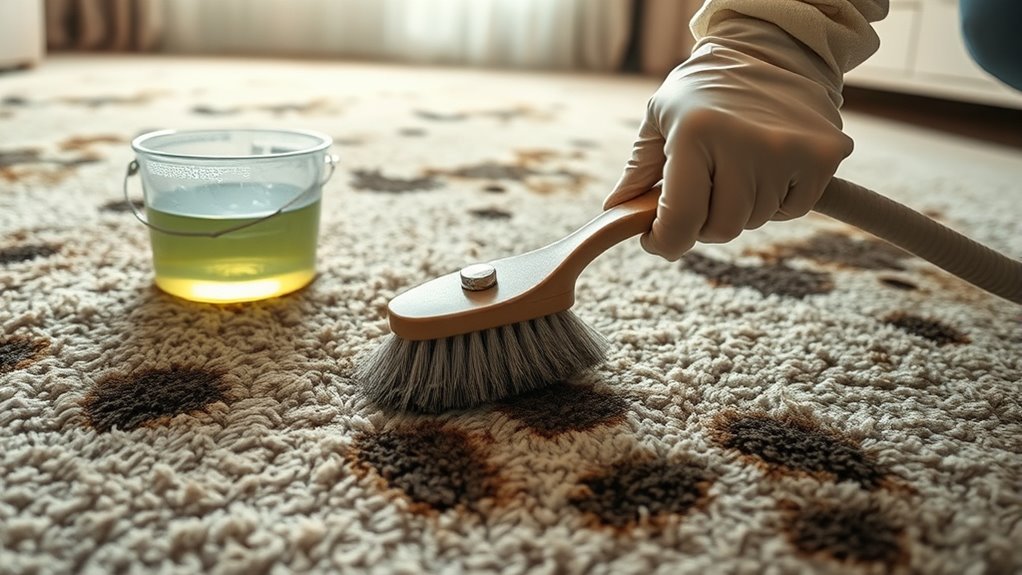Removing Mold Stains From Carpets
If you find mold stains on your carpet, start by identifying the mold type and wearing protective gear to avoid exposure. Vacuum the area with a HEPA filter to remove spores, then apply an EPA-approved cleaner or a vinegar solution. Scrub gently and dry thoroughly to prevent moisture retention. Managing humidity and prompt spill cleanup will help stop mold from coming back. For stubborn or widespread mold, professional services might be necessary. Keep exploring to understand each step in detail.
Identifying Mold Stains and Assessing Damage

How can you accurately identify mold stains on your carpet and determine the extent of the damage? Begin by recognizing common mold types such as Aspergillus, Cladosporium, and Stachybotrys, each exhibiting unique stain characteristics. Mold stains typically appear as irregularly shaped, discolored patches ranging from black, green, or white to yellowish hues. You’ll notice a musty odor and possibly a powdery or fuzzy texture. Assess the damage by inspecting the carpet’s backing and padding, as mold often penetrates deeply, compromising fiber integrity. Use a flashlight to detect subtle discolorations and moisture presence, which indicates active mold growth. Identifying mold types and stain characteristics precisely allows you to gauge contamination levels, guiding effective removal strategies while preserving your freedom to maintain a healthy living environment.
Essential Tools and Cleaning Solutions Needed
To tackle mold stains effectively, you’ll need to gather specific tools and cleaning solutions designed for mold remediation. Having the right essential tools guarantees you remove mold safely and thoroughly, preserving your carpet’s integrity. Here’s what you should prepare:
- Protective Gear – Gloves, goggles, and a mask to prevent exposure to mold spores.
- Vacuum with HEPA Filter – To capture mold spores without spreading them.
- Cleaning Solutions – Use EPA-approved mold cleaners or a mixture of white vinegar and water for effective mold elimination.
- Scrubbing Brushes – Stiff-bristled brushes to agitate the carpet fibers and lift mold stains.
Equipped with these essential tools and cleaning solutions, you’ll maintain control over the mold removal process efficiently and safely.
Step-by-Step Mold Removal Process

Once you have all the necessary tools and cleaning solutions ready, you can begin the mold removal process. First, identify the mold types affecting your carpet fibers to select the best treatment. Next, carefully vacuum the area to remove loose spores without spreading them. Then apply the appropriate cleaning solution, allowing it to penetrate deeply. Finally, blot and air-dry to prevent moisture retention.
| Step | Action | Purpose |
|---|---|---|
| Identification | Determine mold types | Tailor treatment |
| Vacuuming | Remove loose spores | Minimize spread |
| Treatment | Apply cleaning solution | Eliminate mold on fibers |
| Drying | Blot and air-dry | Prevent recurrence |
Following these precise steps guarantees effective mold stain removal while preserving carpet integrity.
Preventative Measures to Avoid Mold Recurrence
Although thorough cleaning removes existing mold stains, preventing recurrence requires controlling environmental factors that promote mold growth. To maintain a mold-resistant carpet environment, focus on:
Thorough cleaning removes mold stains, but controlling moisture and humidity is key to preventing its return.
- Humidity Control: Keep indoor humidity below 60% using dehumidifiers or air conditioners to inhibit mold spores.
- Proper Ventilation: Guarantee adequate airflow in rooms with carpets, especially basements and bathrooms, to reduce moisture accumulation.
- Prompt Moisture Removal: Address spills and leaks immediately to prevent dampness that fosters mold growth.
- Use Mold-Resistant Carpeting: Consider carpets treated with antimicrobial agents or synthetic fibers less prone to mold development.
When to Seek Professional Carpet Cleaning Services

If mold stains persist despite your best efforts, or if the affected area is extensive, it’s wise to seek professional carpet cleaning services. Professionals provide thorough mold inspection, identifying hidden fungal growth that DIY methods might miss. They use specialized equipment and antimicrobial treatments to eradicate mold spores effectively, reducing health risks and preventing recurrence. Additionally, if mold damage compromises carpet integrity beyond cleaning, experts can advise on carpet replacement to guarantee your living space remains safe and mold-free. Opting for professional intervention not only restores your carpet’s appearance but also safeguards your environment, giving you the freedom to live comfortably without ongoing mold concerns. Don’t hesitate to consult specialists when mold issues exceed manageable limits or when health hazards arise.
Frequently Asked Questions
Can Mold Stains Cause Health Problems for Pets?
Yes, mold stains can cause health problems for your pets. When your pets experience mold exposure, it can trigger pet allergies, leading to symptoms like sneezing, coughing, skin irritation, and respiratory issues. Prolonged exposure might worsen their condition, making it vital to address mold presence promptly. You’ll want to guarantee your living space is mold-free to protect your pets’ health and maintain a comfortable environment for everyone.
Are There Eco-Friendly Mold Removal Products for Carpets?
Think of your carpet as a delicate ecosystem, where every fiber breathes freely. You’ll find eco-friendly mold removal products that respect this balance through natural cleaning agents and biodegradable solutions. These products effectively break down mold without harsh chemicals, preserving your carpet’s integrity and your indoor air quality. By choosing them, you maintain a healthy environment while enjoying the freedom to live mold-free, responsibly and sustainably.
How Long Does It Take for Mold to Grow on Carpets?
Mold growth timeline on carpets typically begins within 24 to 48 hours when conditions are right. You’ll notice that carpet moisture factors, like humidity levels above 60% and dampness from spills or leaks, accelerate this process. If your carpet stays wet or damp for more than two days, mold spores can start colonizing quickly. So, controlling moisture is key to preventing mold from taking hold and spreading.
Does Carpet Type Affect Mold Growth Susceptibility?
Carpet composition critically controls contamination chances. Different carpet materials demonstrate distinct mold resistance levels. Natural fibers like wool absorb moisture easily, making them more mold-prone, while synthetic fibers such as nylon or polyester typically repel moisture, offering better mold resistance. So, if you want freedom from fungal foes, choosing the right carpet type matters. Understanding these material-specific susceptibilities helps you make informed decisions to minimize mold growth risks effectively.
Can Mold Stains Be Removed From Carpet Padding?
Mold stains on carpet padding are notoriously difficult to remove because padding is porous and absorbs moisture deeply. While surface cleaning might reduce visible stains, complete removal often requires padding replacement to guarantee mold doesn’t return. For effective stain prevention, controlling humidity and promptly addressing spills is vital. If you want to maintain freedom from recurring mold issues, replacing affected padding is usually the most reliable technical solution.






